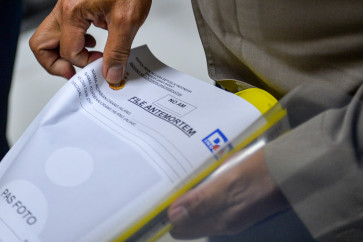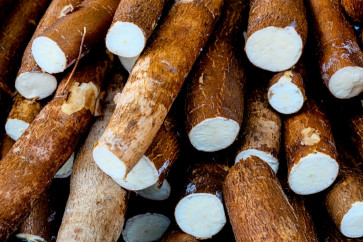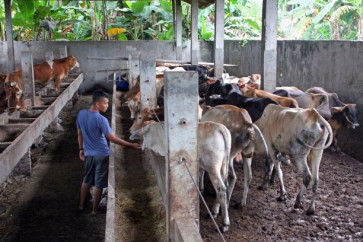Dolorosa Sinaga’s biography: A story of art and activism
Life story: Sculptor and feminist icon Dolorosa Sinaga interacts with visitors during the launch of her biography at the National Gallery of Indonesia in Jakarta on Friday
Change text size
Gift Premium Articles
to Anyone

L
ife story: Sculptor and feminist icon Dolorosa Sinaga interacts with visitors during the launch of her biography at the National Gallery of Indonesia in Jakarta on Friday. (Courtesy of National Gallery of Indonesia)
Venerable sculptor and feminist icon Dolorosa Sinaga celebrated her illustrious career spanning more than four decades with the launch of her biography, Dolorosa Sinaga: Tubuh, Bentuk, Substansi (Dolorosa Sinaga: Body, Form, Matter).
The book, available in both English and Indonesian, was launched on Friday at the National Gallery in Central Jakarta. An exhibition titled 40 Tahun Aktivisme Seni Dolorosa Sinaga (40 Years of Art Activism by Dolorosa Sinaga) accompanied the launch, and will run until Feb. 11.
Designed as a coffee table book, Dolorosa Sinaga: Tubuh, Bentuk, Substansi does not come cheap: The hardcover edition retails at Rp 1.8 million (US$132.51), while the softcover edition is a smidge more affordable at Rp. 1.2 million.
However, those who purchase the book during the exhibition period will receive a 15 percent discount. As of the time of writing, the only way to acquire the book is by filling out a form available in the exhibition space.
At 504 pages in length, Dolorosa Sinaga: Tubuh, Bentuk, Substansi is divided into five chapters, including a chapter featuring some 30 essays by writers of varying disciplines on Dolorosa and her works.
Art historians Alexander Supartono and Sony Karsono edited the book, with the creation process taking approximately three years to complete.
A large chunk of the book is dedicated to a catalogue of Dolorosa’s sculptures: approximately 620 works dating back as early as 1976 with Bertolak Belakang (Contradictory) to her latest sculpture Penghargaan Tokoh Budaya (Cultural Figure Awards) from 2018.
According to Alexander, the catalogue is a vital part of the book, with the documentation process taking the longest to complete.
“To our knowledge, this book offers something that has never been presented by other books on sculpture, which is including and annotating the variations and editions of each sculpture ever produced [by Dolorosa],” he said.
Along with the catalogue, Alexander highlighted a sociogeographic essay by Sony on Dolorosa’s life. The catalogue and the biographical essay, he continued, worked in tandem to provide context to the artist.
During a tour of the exhibition, Sony noted that a crucial context in the book’s content was the dimension of gender, as Dolorosa was born to a Batak family who favored sons.
Dolorosa’s father had expressed his wish to have a son, which Sony said highlighted how her struggle in gender relations started before she was born.
In her time, becoming an artist was not an easy path to follow. Before enrolling in the Jakarta Institute of the Arts (LPKJ) — where she teaches to this day — Dolorosa often argued with her father, who wanted her to become a priestess.
As the first graduate of LPKJ in 1977, Dolorosa was pictured being congratulated by the then-governor of Jakarta Ali Sadikin, someone Sony said was one of the few governors of Jakarta who knew how to support the arts.
In 1980, Dolorosa received a scholarship from the British Council to study at the St. Martin’s School of Art, receiving a postgraduate degree under the tutelage of students of the English abstract sculptor Anthony Caro.
Returning to Indonesia after interning at Piero Mussi’s Artworks Foundry in Berkeley, the United States, Dolorosa founded the Somalaing Art Studio in 1987, before taking up the mantle of dean at the school of arts at IKJ from 1992 to 2001.
Since then, Dolorosa has often created artworks both commissioned and for donation, such as Solidaritas (Solidarity), which she donated to the National Commission on Violence Against Women (Komnas Perempuan) in 2002, and General, Have You Read The Book of Love?, which she donated to Amnesty International Indonesia in 2017.
This year, Dolorosa will create a statue of Indonesia’s founding father Sukarno to be placed in Algiers. She said that Sukarno had been an inspiring figure in the nation’s push for independence.
Sony noted that the book would have the long-term effect of contributing to arts education in Indonesia, saying that he hoped that after the book was launched and read by people all over the country, other Indonesian artists could tread the path blazed by Dolorosa, a path that saw artists support and invite academics to catalogue their works and invite various interpretations.
“Something Dolorosa said that really struck me when writing the book with Alexander was that for her, interpretations of her work are more valuable than her previous works.
“From this, we can observe Dolorosa’s intellectual generosity; she doesn’t just provide art for the world, she also wants people to enjoy it by sharing knowledge,” Sony said.









